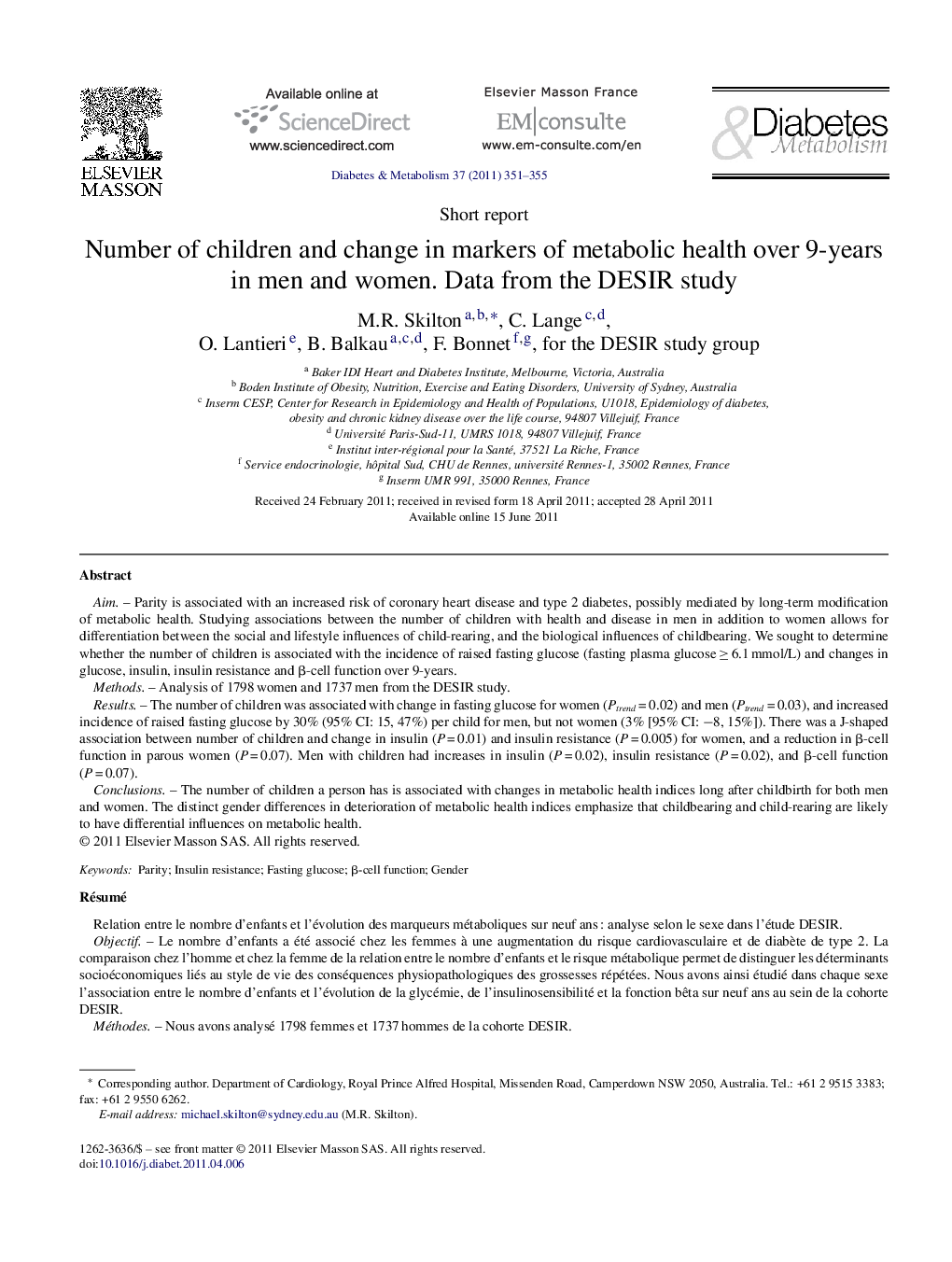| کد مقاله | کد نشریه | سال انتشار | مقاله انگلیسی | نسخه تمام متن |
|---|---|---|---|---|
| 3260304 | 1207610 | 2011 | 5 صفحه PDF | دانلود رایگان |

AimParity is associated with an increased risk of coronary heart disease and type 2 diabetes, possibly mediated by long-term modification of metabolic health. Studying associations between the number of children with health and disease in men in addition to women allows for differentiation between the social and lifestyle influences of child-rearing, and the biological influences of childbearing. We sought to determine whether the number of children is associated with the incidence of raised fasting glucose (fasting plasma glucose ≥ 6.1 mmol/L) and changes in glucose, insulin, insulin resistance and β-cell function over 9-years.MethodsAnalysis of 1798 women and 1737 men from the DESIR study.ResultsThe number of children was associated with change in fasting glucose for women (Ptrend = 0.02) and men (Ptrend = 0.03), and increased incidence of raised fasting glucose by 30% (95% CI: 15, 47%) per child for men, but not women (3% [95% CI: −8, 15%]). There was a J-shaped association between number of children and change in insulin (P = 0.01) and insulin resistance (P = 0.005) for women, and a reduction in β-cell function in parous women (P = 0.07). Men with children had increases in insulin (P = 0.02), insulin resistance (P = 0.02), and β-cell function (P = 0.07).ConclusionsThe number of children a person has is associated with changes in metabolic health indices long after childbirth for both men and women. The distinct gender differences in deterioration of metabolic health indices emphasize that childbearing and child-rearing are likely to have differential influences on metabolic health.
RésuméObjectifLe nombre d’enfants a été associé chez les femmes à une augmentation du risque cardiovasculaire et de diabète de type 2. La comparaison chez l’homme et chez la femme de la relation entre le nombre d’enfants et le risque métabolique permet de distinguer les déterminants socioéconomiques liés au style de vie des conséquences physiopathologiques des grossesses répétées. Nous avons ainsi étudié dans chaque sexe l’association entre le nombre d’enfants et l’évolution de la glycémie, de l’insulinosensibilité et la fonction bêta sur neuf ans au sein de la cohorte DESIR.MéthodesNous avons analysé 1798 femmes et 1737 hommes de la cohorte DESIR.RésultatsLe nombre d’enfants était associé avec l’augmentation de la glycémie, à la fois chez les femmes (Ptendance = 0,02) et les hommes (Ptendance = 0,03). L’incidence de l’hyperglycémie à jeun (glycémie plasmatique à jeun ≥ 6,1 mmol/L) était significativement augmentée de 30 % (IC 95 % : 15, 47 %) par enfant chez les hommes mais non chez les femmes (3 % [IC 95 % : −8, 15 %]). Il existait chez les femmes une relation en J entre le nombre d’enfants et les variations de l’insulinémie (P = 0,01) et de l’index d’insulinorésistance HOMA au cours du temps (P = 0,005). Chez les hommes avec enfants, il existait une augmentation de l’insulinémie (P = 0,02), de l’index d’insulinorésistance (P = 0,02) et du HOMA bêta (P = 0,07).ConclusionsLe nombre d’enfants est significativement associé à une augmentation de la glycémie et de l’insulinémie au cours du temps, à la fois chez les femmes et les hommes. Les grossesses répétées et le fait d’élever plusieurs enfants semblent avoir chacun un impact différent sur les modifications des paramètres du métabolisme glucidique.
Journal: Diabetes & Metabolism - Volume 37, Issue 4, September 2011, Pages 351–355